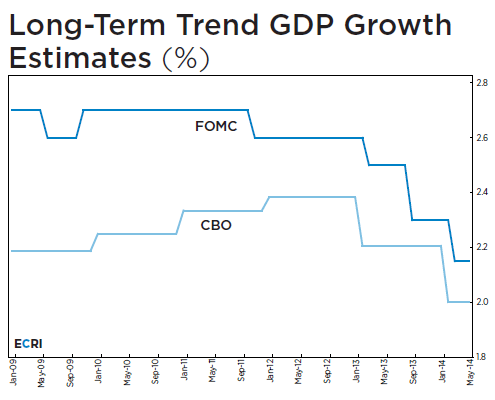Summary: The US economy has repeatedly failed to resume normal growth after the crash. But potentially worse is the decline in long-term growth estimates. This is part one of two posts describing the dilemma.
In January 2011 the Federal Research estimated the long-term growth rate of the US economy at 2.5 – 2.8%. By June this year their estimate had fallen to 2.1 – 2.3%. Years of low investment by the private and public sector (see links below), a decaying education system, rising debt levels, and demographic headwinds (an aging society) — all these things are slowing America’s growth.
The potential boost from technology so far remains speculation about the future.
For tangible evidence see the economy’s inability to “take off” since the crash (GDP has limped along at an average of 2.2%). On January 3 JP Morgan forecast 2014 GDP to be 2.8%, the fastest since 2005. Now they expect half that, 1.4% — the slowest since the 2008 crash.
That’s far too close to the economy’s stall speed of 2%, below which it’s at risk of falling into recession — much like an airplane going too slow, generating insufficient lift to stay aloft (this is a controversial theory; now we’re testing it). Perhaps the US economy cannot accelerate by much from current growth rates (without undesirable rates of inflation), and it cannot slow without falling into recession (ruinous under current conditions, with monetary policy tapped out (ZIRP), fiscal deficits and unemployment still too high (but falling).
This will make economic management quite difficult for the foreseeable future. Persistent slow speed will create pressure for stimulus (perhaps with long-term ill consequences). Failure to quickly stimulate to even small mistakes might easily trip the economy into recession.
The Economic Cycle Research Institute also sees the problem
Excerpt from “Cognitive Dissonance at the Fed?“, ECRI, 30 May 2014:
Federal Open Market Committee (FOMC) members have long submitted their projections of U.S. real GDP growth for the “longer run,” to which they expect it “to converge over time – maybe in five or six years – in the absence of further shocks and under appropriate monetary policy.”
… So what is being gradually acknowledged – without any publicity or fanfare – is that long-term U.S. GDP trend growth is converging towards its 2% stall speed. If so, almost every time GDP growth experiences a slowdown that carries it below trend, it will also fall below the recessionary stall speed. This is an implicit endorsement of ECRI’s longstanding “yo-yo years” thesis, which predicts more frequent recessions for the advanced economies than we have seen in past decades.
Separately, a recent ECRI report (click to download) demonstrates how the yo-yo years are already a fact.
About the Economic Cycle Research Institute
The ECRI is an independent research institute. Their indicator systems predict the timing of changes in an economy’s direction, before the consensus of economists. For information about their approach, see their About page.
New hot research about slowing growth in the US
(a) “Declining Business Dynamism in the United States: A Look at States and Metros“, Ian Hathaway and Robert E. Litan, The Brookings Institution, May 2014 — Abstract”
Business dynamism is the process by which firms continually are born, fail, expand, and contract, as some jobs are created, others are destroyed, and others still are turned over. Research has firmly established that this dynamic process is vital to productivity and sustained economic growth. Entrepreneurs play a critical role in this process, and in net job creation.
But recent research shows that dynamism is slowing down. Business churning and new firm formations have been on a persistent decline during the last few decades, and the pace of net job creation has been subdued. This decline has been documented across a broad range of sectors in the U.S. economy, even in high-tech.
… we show that dynamism has declined in all 50 states and in all but a handful of the more than 360 U.S. metropolitan areas during the last three decades. Moreover, the performance of business dynamism across the states and metros has become increasingly similar over time. In other words, the national decline in business dynamism has been a widely shared experience. While the reasons explaining this decline are still unknown, if it persists, it implies a continuation of slow growth for the indefinite future, unless for equally unknown reasons or by virtue of entrepreneurship-enhancing policies (such as liberalized entry of high-skilled immigrants), these trends are reversed.
(b) “Productivity and Potential Output Before, During, and After the Great Recession“, John G. Fernald, Federal Reserve Bank of San Francisco,
June 2014 — Abstract:
US labor and total-factor productivity growth slow ed prior to the Great Recession. The timing rules out explanations that focus on disruptions during or since the recession, and industry and state data rule out “bubble economy” stories related to housing or finance. The slowdown is located in industries that produce information technology (IT) or that use IT intensively, consistent with a return to normal productivity growth after nearly a decade of exceptional IT-fueled gains.

